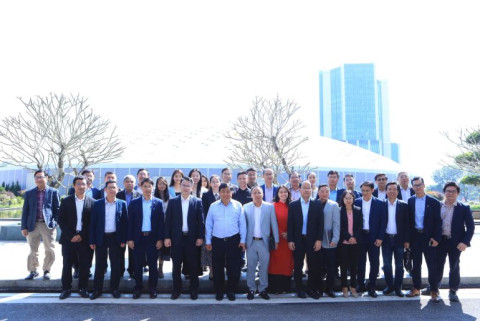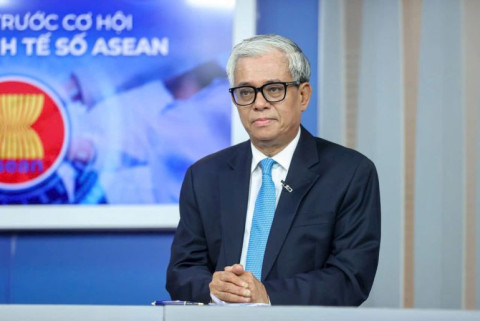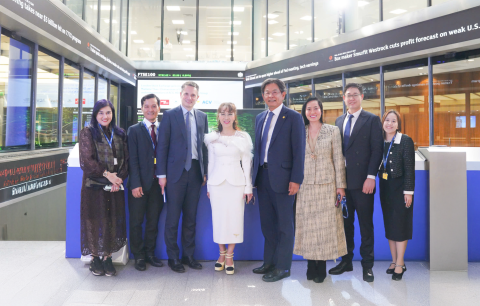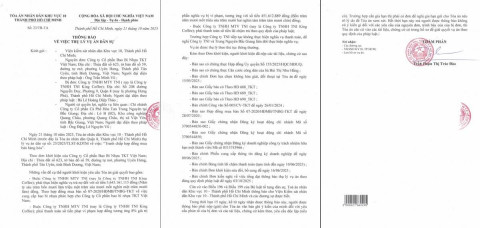North-South High-Speed Railway Investment is a Major Step Forward for Vietnam’s Transport Infrastructure
- 195
- Business
- 18:40 25/01/2024
DNHN - The high-speed railway project, currently being implemented by the Ministry of Transport, has received special attention from the community and marks a significant step forward in improving the quality and efficiency of the national transport system.
Accordingly, the high-speed railway project in Vietnam is one of the country’s most important infrastructure projects in the coming period, aiming to improve the quality of transport and facilitate travel throughout the country. The Ministry of Transport (MoT) is implementing this project to build a modern railway network that meets the needs of transporting goods and people quickly and safely.
Specifically, the high-speed railway project in Vietnam includes the construction and development of new railway lines, designed to achieve high operating speeds of 200 km/h or more. These railway lines will connect major cities and key economic regions of the country, facilitating travel and economic development.
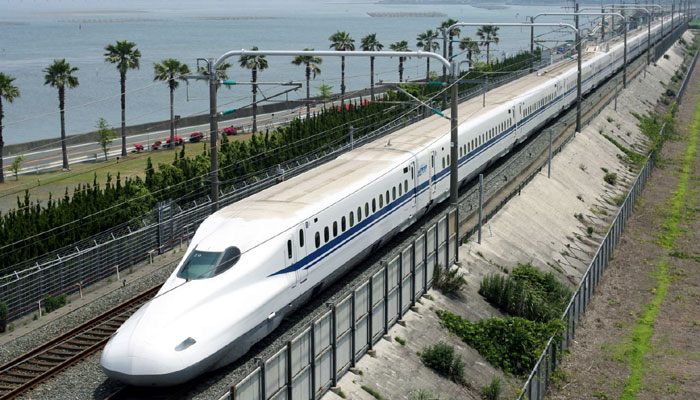
The benefits of the project are to improve transport efficiency, the high-speed railway system helps to reduce road congestion, traffic jams and travel time. This means increasing economic efficiency and reducing environmental pollution.
Thus, the high-speed railway network will facilitate the transportation of goods and the promotion of Vietnam’s brand. It also creates many new investment opportunities, attracts domestic and foreign capital, and promotes economic development in key economic regions. In addition, the high-speed railway project is considered a green means of transport, with energy-saving fuel consumption and reduced polluting emissions compared to personal vehicles. By encouraging people to use high-speed rail, this project contributes positively to environmental protection and sustainable development.
As planned, the high-speed railway project in Vietnam has achieved remarkable achievements. The railway lines have been built and implemented, such as the Hanoi - Hai Phong high-speed railway line and the North-South railway line. At the same time, the MoT is also continuing to carry out procedures to implement the project in the coming time, to expand the high-speed railway network and improve the quality of transport services.
According to the MoT, according to the National Master Plan for the period 2021 - 2030, with a vision to 2050, and the railway network planning for the period 2021 - 2030, with a vision to 2050, the high-speed railway line on the North-South axis has a scale of double track, 1,435mm gauge, with a length of about 1,545km, the investment schedule before 2030.
Previously, the Politburo issued Conclusion 49/2023 on the orientation of Vietnam’s railway transport development to 2030, with a vision to 2045, requiring the project to study, analyse, evaluate, and refer to international experience to select a modern investment and construction option, with a long-term vision, promoting the advantages and potentials of the country, in line with the development trend of the world; the goal is to strive to complete the approval of the project’s investment policy by 2025.
Implementing the conclusion of the Politburo, the Prime Minister established the Steering Committee for the construction and implementation of the project on the investment policy for the high-speed railway on the North-South axis and key national projects. The Steering Committee has met to give direction on the content of the North-South high-speed railway project.
Implementing the direction of the Steering Committee, the MoT has consulted with the Central Party Committees, the Committees of the National Assembly and the ministries and branches to finalise and submit to the Government’s Standing Committee.
As planned, after the North-South high-speed railway project is approved by the competent authority, the MoT will complete the project’s Pre-Feasibility Study Report and submit it to the National Assembly for approval of the investment policy during the term of the 15th National Assembly and strive to start construction of the two priority sections before 2030.
It can be seen that the high-speed railway project in Vietnam implemented by the MoT has made an important contribution to the development of the country’s transport infrastructure and economy. With outstanding benefits such as improving transport efficiency, promoting economic development, saving energy and protecting the environment, this project has created new development opportunities and brought convenience to people. The progress of the high-speed railway project has been and continues to be a clear testament to Vietnam’s sustainable development in the field of transport infrastructure.
The North-South high-speed railway project has a total investment of about 58.71 billion USD, including site clearance cost of 1.98 billion USD, construction cost of 31.58 billion USD, equipment cost of 15 billion USD, project management cost, consultancy, other 5.82 billion USD, and contingency cost of 4.07 billion USD.
Phase 1 invests in the Hanoi - Vinh section and the Nha Trang - Ho Chi Minh City section, with a length of 665km, the total investment is expected to be 24.72 billion USD, including preparing for investment for the entire route in the period 2020 - 2026, construction in the period 2027- 2031, put into operation around 2032. Phase 2 invests in the Vinh - Nha Trang section to connect the entire route, with a length of 894km, the total investment is expected to be 33.99 billion USD, including around 2040, the Vinh - Da Nang section will be put into operation; around 2045 - 2050, the Da Nang - Nha Trang section will be put into operation.
Nghe Nhan
Related news
- Connecting Leaders, Shaping the Future: Strategic Leadership Planning Meeting – CorporateConnections Hanoi A
- Sunlight - Unilever Vietnam Recognized for Outstanding Contributions to the National Initiative Supporting Women Entrepreneurs
- Deputy Prime Minister Nguyễn Chí Dũng: “The country’s major challenges weigh heavily on my mind — and we must resolve them together.
- Unitsky String Technologies signs cooperation agreements with three Vietnamese partners, opening a new direction for smart mobility and sustainable development
- When artists do business – livelihood is no poetry!
- Before the D‑day to abolish flat‑rate tax: Fear of technology and costs leave small traders struggling to adapt
- Vietnamese enterprises at a crossroads: the impact of a potential US–China deal
- "Digital technicians" must not be forgotten if Vietnam aims to meet its strategic goals
- HDBank: Impressive profit growth, leading in profitability and advancing international integration
- TNI King Coffee sued for over VND 5 Billion in unpaid debts
- VINASME and Jeonnam Technopark Sign MOU on technology cooperation, human resource training, and trade promotion
- Vietnamese entrepreneurs strengthen ASEAN connectivity in the digital iIntegration era
- Prime Minister: Vietnam aims to become a regional logistics hub
- Vietnam upgraded to Secondary Emerging Market by FTSE Russell
- Hanoi’s economy grows 7.92% in first nine months of 2025, FDI surges nearly threefold
- Vietnam’s strong gdp growth fails to ease labor market distress
- US tariffs on Brazil propel Vietnam’s pangasius into global spotlight
- VietLeap AI Accelerator launches: A strategic springboard for Vietnam’s AI startups
- CICON expands strategic alliances: A new step forward in Vietnam–Korea business connectivity
- What must Vietnamese enterprises do to maintain their position in the global supply chain?
Đọc thêm Business
Connecting Leaders, Shaping the Future: Strategic Leadership Planning Meeting – CorporateConnections Hanoi A
"Your network is your most powerful flowing asset. It generates value, multiplies opportunities, and accelerates your influence across borders."
Innovative ESG enterprise: Trạm Xe Việt startup proposes solutions to build a green mobility ecosystem
As Vietnam commits to achieving Net Zero by 2050 and tightens emissions standards, the transportation sector faces unprecedented pressure to transform.
Deputy Prime Minister Nguyễn Chí Dũng: “The country’s major challenges weigh heavily on my mind — and we must resolve them together.
On the morning of November 26, 2025, Deputy Prime Minister Nguyễn Chí Dũng chaired a high-level working session at the National Innovation Center (NIC) in Hòa Lạc.
Unitsky String Technologies signs cooperation agreements with three Vietnamese partners, opening a new direction for smart mobility and sustainable development
The signing ceremony took place in Minsk, Belarus, on November 28, 2025.
Before the D‑day to abolish flat‑rate tax: Fear of technology and costs leave small traders struggling to adapt
From 1 January 2026 the flat‑rate tax regime will be abolished. Small business households will be required to declare tax based on actual revenue. MISA supports the transition with technology to help micro‑merchants adapt smoothly and transparently.
Vietnamese enterprises at a crossroads: the impact of a potential US–China deal
As the world closely monitors every shift in US-China relations, emerging signals of a strategic agreement between the two global powers are raising hopes for global economic stability.
HDBank: Impressive profit growth, leading in profitability and advancing international integration
Ho Chi Minh City Development Joint Stock Commercial Bank (HDBank, stock code HDB) announced its consolidated profit before tax for the first 9 months of 2025 reached VND 14,803 billion, marking a 17% increase year-on-year (YoY).
TNI King Coffee sued for over VND 5 Billion in unpaid debts
On October 21, 2025, the People’s Court of District 10 in Ho Chi Minh City officially accepted a civil lawsuit concerning a commercial contract dispute between TKT Vietnam Plastic Packaging Joint Stock Company and TNI King Coffee Co., Ltd.
VINASME and Jeonnam Technopark Sign MOU on technology cooperation, human resource training, and trade promotion
On October 15, 2025, in Hanoi, VINASME and Jeonnam Technopark (Korea) signed an MOU to promote trade, advance technology transfer, and develop human resources between enterprises of both nations.
Vietnamese entrepreneurs strengthen ASEAN connectivity in the digital iIntegration era
On the occasion of Vietnam Entrepreneurs’ Day (October 13), an international event themed “Integration – Innovation – Sustainable Development” was solemnly held in Ho Chi Minh City.




